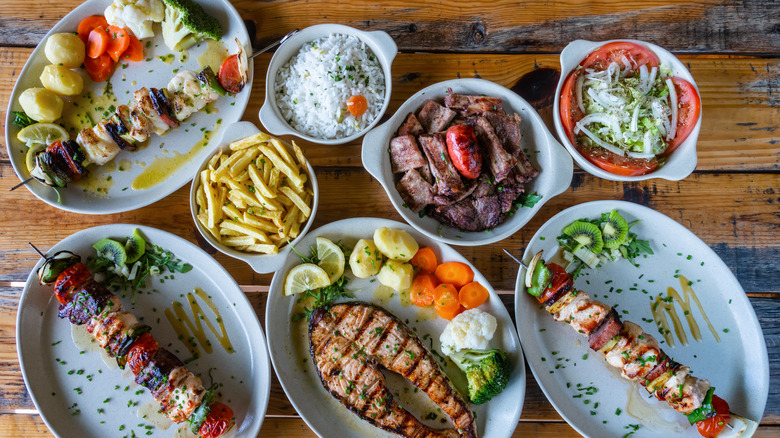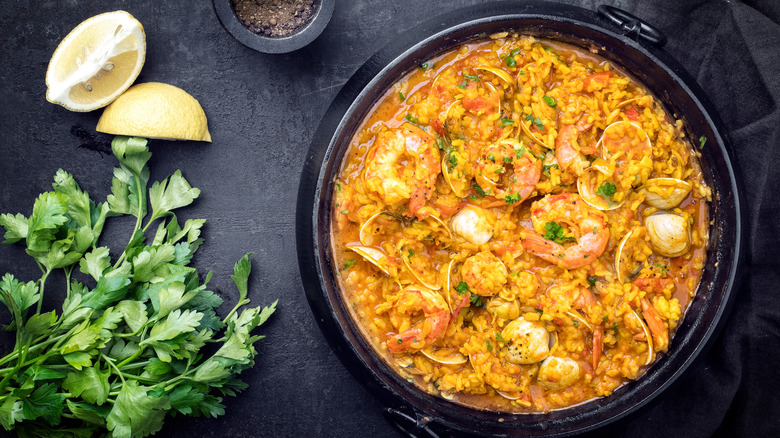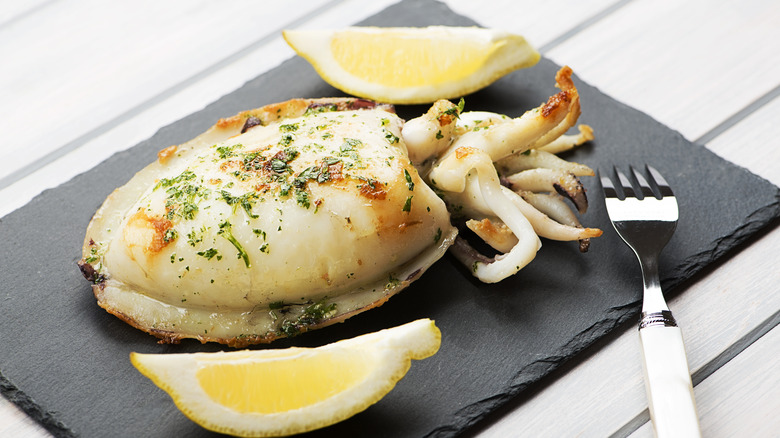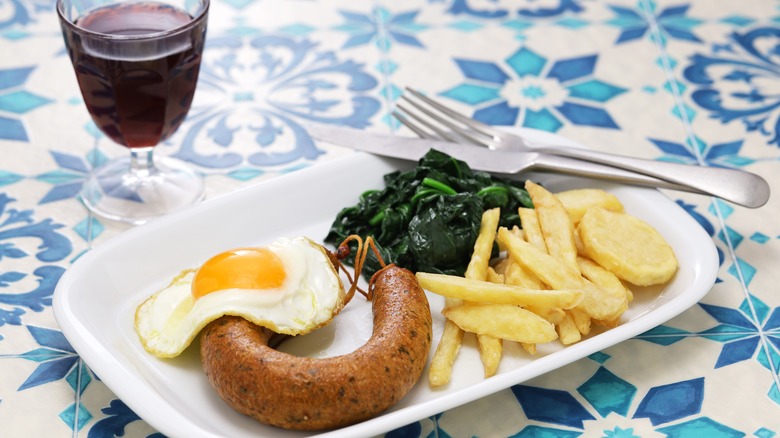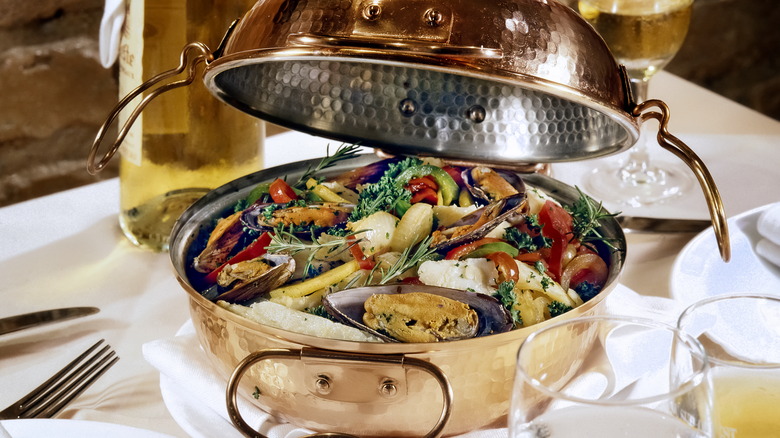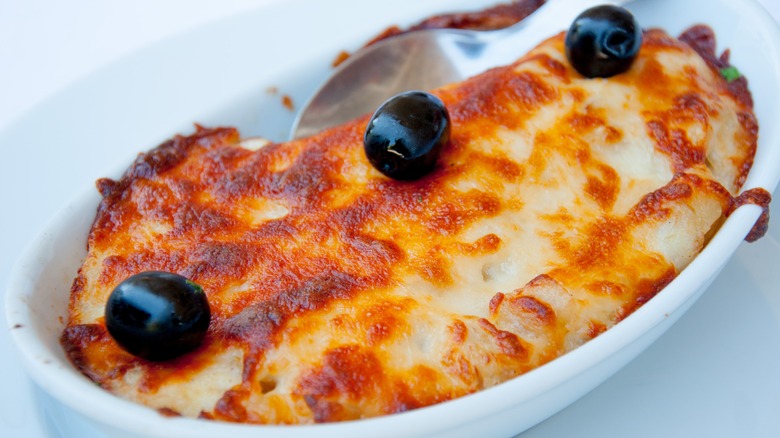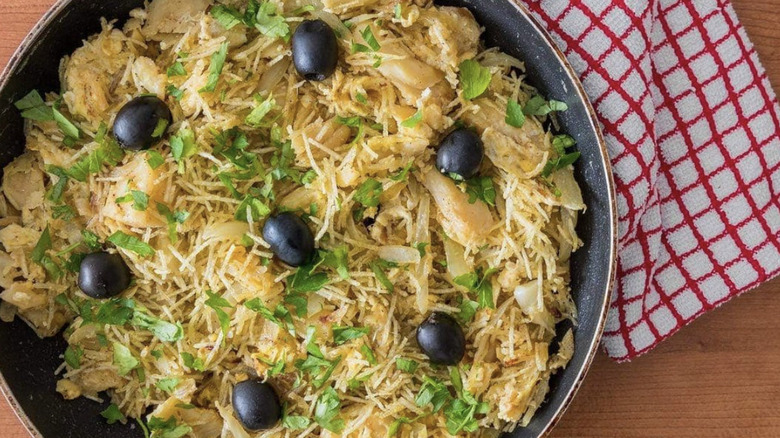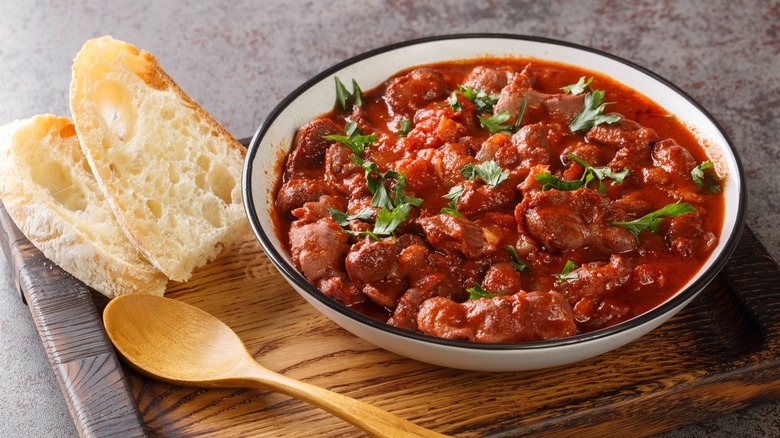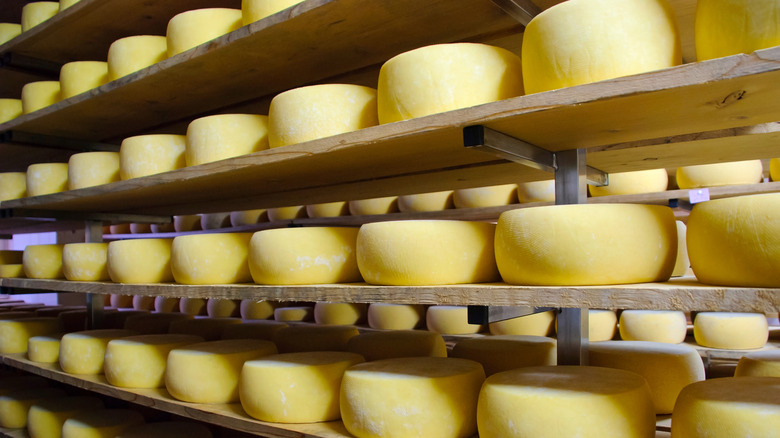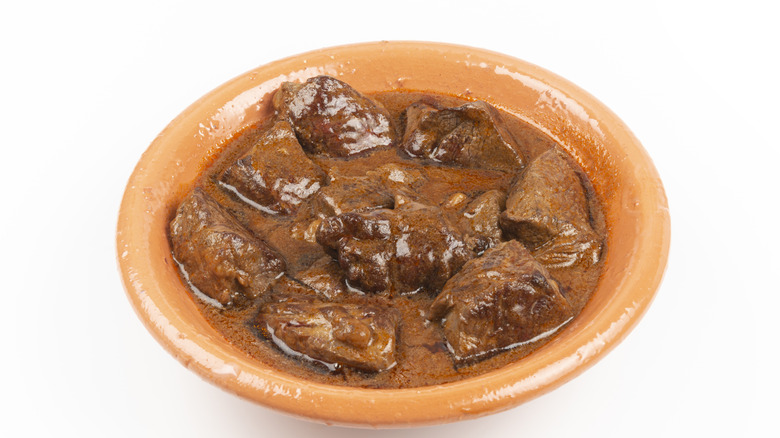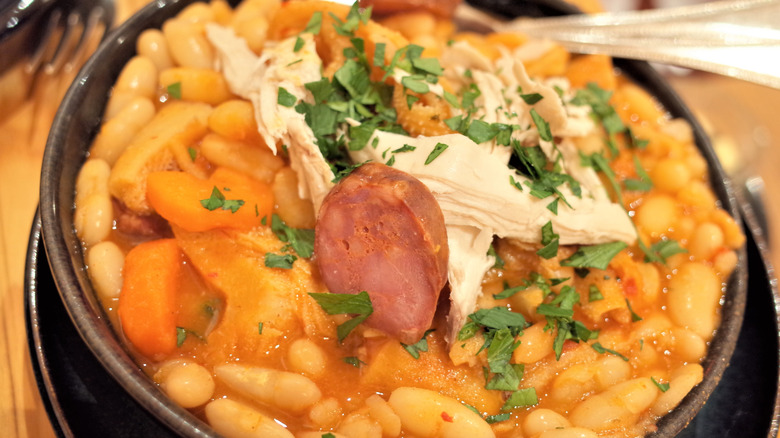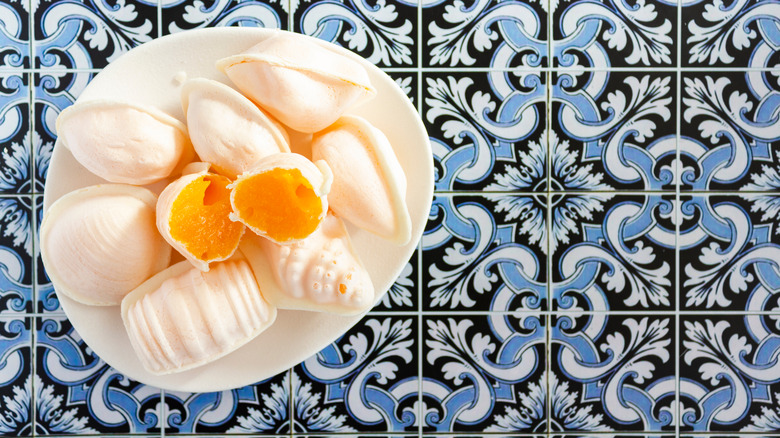12 Foods You Have To Try In Portugal
Portugal has recently become one of the most popular destinations for summer visitors. Thanks to its gorgeous weather, beautiful beaches, and rich culinary culture, this small country on the Atlantic ocean has drawn more and more tourists every year. That being said, not all visitors travel to the country knowing what type of food to order at local restaurants.
Of course, many of the folks who are interested in Portugal have heard of the Francesinha. Featured in an episode of "Parts Unknown," this legendary sandwich is known by many as the dish that made Anthony Bourdain declare, "Good lord, look at that thing! Is there a vegetable in there?" (via YouTube). Invented in the city of Porto in the 1950s, the Francesinha contains a shocking amount of chorizo, steak, and ham. What's more, it is covered with a thick layer of melted cheese, smothered in a savory tomato beer sauce, and served with a runny fried egg on top.
As delicious as the famed Francesinha is, it is far from being the only thing to eat in Portugal. Indeed, this oceanside country boasts incredible offerings, including fresh fish, homemade sausages, and egg-based desserts. From the delightful seafood dish called "arroz de marisco" to the satisfying dessert of "ovos moles de Aveiro," these are the top eats to try on your trip to Portugal.
1. Arroz de marisco
Arroz de marisco may mean "seafood rice" in English, but don't confuse it with Spanish paella. Although this hearty Portuguese dish shares certain ingredients with its Spanish competitor, it is completely unique. What's more, the Portuguese "7 Wonders" project even considers it one of the 7 wonders of Portuguese cuisine.
While paella originated with hungry farmers on the beaches of Valencia, arroz de marisco comes from a beach in the central Portuguese region of Leiria. Known as Praia de Vieira, this special spot provided the perfect conditions for local cooks to procure the unique mixture of clams, lobster, and prawns that go into this dish. Unlike paella, which has a crunchy outer crust, arroz de marisco resembles a stew. After all, the dish is prepared by combining seafood with cilantro and peppers and cooking it all together in an orange sauce filled with carolino-style rice.
Beyond its ingredients and consistency, however, arroz de marisco stands out for the unique way it is served — especially at Praia de Vieira. There, if you order arroz de marisco, a waiter will come to your table with a clay pot that is overflowing with this delightful stew. On many occasions, the liquid will still be boiling when it arrives at your table. As a result, you might have to wait a few minutes to take your first bite.
2. Chocos grelhados com tinta
"Chocos," or "cuttlefish," might not be the most common thing to eat in the United States, but in Portugal, this sea dweller is king. As a crustacean, the cuttlefish is somewhat reminiscent of octopus or squid. After all, its tentacles (albeit short ones), chewy texture, and ink-filled sacs bring these other creatures to mind. However, in terms of flavor, cuttlefish is its own thing.
In Portugal, this sea creature is often prepared by throwing it on the grill over a bed of hot coals. This process gives the animal's white flesh a crispy brown outer layer that carries a deep, savory caramel flavor. Meanwhile, the inner areas of the cuttlefish grow creamy and rich, like butter. The result is a decadent dish called "chocos grelhados," which accentuates the contrast between the cuttlefish's thicker outer layer and its softer interior.
Interestingly, in most parts of Portugal, chocos grelhados can be served in two different ways: with ink ("com tinta") or without it ("sem tinta"). While not everybody enjoys the thicker consistency of cuttlefish with ink, we fully recommend that you try this dish. The reason is that cuttlefish ink is overflowing with umami – and many people consider it a more balanced alternative to squid ink. When served with its ink still inside, your choco grelhados will take on an extra layer of richness thanks to this special boost of flavor.
3. Alheira
There are many different types of sausages enjoyed on the Iberian Peninsula, where Portugal is located. However, none may have such a powerful history as the alheira sausage. This unique dish dates back to 1536 when the Inquisition took over Portugal. During this time, people who practiced Judaism and Islam were persecuted by the local government, which refused to accept any religion other than Catholicism in the region. In fear of public shaming or even death, many practicing Muslims and Jews went undercover, hiding their prayers in the pages of family Bibles and going to church.
However, for many Jewish Portuguese people, in particular, these practices were not enough to camouflage their identities. As explained by a report in the BBC, families would be reported to the Inquisition for not eating pork sausages — at the time, this was viewed as a sign that someone was still practicing Judaism. To deal with this type of culinary policing, a Jewish community in the Northern region of Trás-os-Montes began making a special type of sausage out of chicken and bread. Dubbed "alheira," this unique dish resembled a traditional pork sausage enough that it tricked could trick representatives of the Inquisition into believing that a Jewish family was Catholic.
These days, alheira remains a popular dish in Portugal. Served with rice, veggies, and a fried egg, it makes for a well-balanced lunch. Even so, the truth remains that 500 years ago, this Portuguese food once saved lives.
4. Cataplana
Alheira sausages are far from being the only type of Portuguese food with a fascinating past. Cataplana, or Portuguese seafood stew, is said to have originated sometime between 700 and 1300 B.C.E. — when the region was occupied by an Islamic empire. Although the exact origins of cataplana remain a mystery, the unique preparation method for this dish does give us a general idea of how it originated.
Unlike most Portuguese stews, cataplana is prepared in a special, round pot that almost looks like two curved pans that have been welded together. Here, the almost bivalve-like shape of the pot is key. While the bottom half is filled with rice, seafood and veggies to cook, the top half is folded over the top of the ingredients. This unusual contraption, thus, allows the chef to easily steam the seafood. The result is a flavorful stew full of the natural juices of the shellfish, shrimp, and other elements.
Interestingly, the uncommon shape of the cataplana pan somewhat resembles the Moroccan "tagine" — a type of pan that steams food via a cone-shaped top. Of course, it is important to note that tagine pans tend to be made of clay, while cataplana pans are typically metallic. However, the general technology of the structures is the same. As a result, many people believe that the cataplana pan came to Portugal via Morocco during the expansion of the Islamic empire.
5. Bacalhau com natas
Bacalhau com natas, "or cod with cream," is a popular Portuguese food. However, that wasn't always the case. Some people might be surprised to learn that cod was not originally fished in Portugal at all. In fact, the Scandinavian Vikings were among the first people in Europe to enjoy this type of fish. Back in the day, these Nordic boatmen appreciated the fact that cod fish is easily preserved drying it out in the sun, making it the perfect solution to surviving those cold Nordic winters. By the 9th century, cod was so important to the Vikings that they used it as currency when trading with other countries. This is how cod arrived in Portugal.
Sometime during the 10th century, it is believed that the Vikings headed down to then-Lusitania, where they traded dried cod for salt. This unusual ingredient quickly grew popular in Portugal. However, inevitably, the Portuguese people had to think of ways to make this dried fish more palatable.
This is where bacalhau com natas comes in. To this day, local cooks start out by soaking and then shredding the dried fish so that it is broken up into thin pieces. They then mix it with cream and potatoes to create a sort of casserole, which they bake in the oven. The result is flavorful, buttery, and utterly decadent.
6. Bacalhau à brás
Bacalhau com natas is not the only type of Portuguese food made with dried cod. Bacalhau à brás is another iconic way to prepare this preserved fish, and, just like in bacalhau com natas, this dish focuses on integrating the cod fish into other types of flavors. Indeed, bacalhau à brás is made by shredding a dried codfish, cooking it with potato strips, and using eggs to hold the mixture together. The resulting dish tones down much of the cod's potent flavor thanks to the addition of the potatoes' more neutral taste.
Although early references to bacalhau à brás are few and far between, rumor has it that this dish originated in Lisbon towards the end of the nineteenth century. Some people believe that it was first served at a nice restaurant located in the city's Bairro Alto — a chic and moneyed part of town. According to this legend, the locale where the dish was invented was called "Braz," inspiring the name bacalhau à brás.
That being said, it is likely that some version of this meal was around well before the nineteenth century. While it certainly took a while for people to label this style of cod "bacalhau à brás," there was a similar dish called "frigideiras de bacalhau" that was around more than 100 years earlier. As per Francisco Borges Henriques' 1715 Portuguese cookbook, "Receitas de milhores doces e de alguns guizados," cod, potatoes, and eggs was a common combination.
7. Moelas em molho de tomate
In Portuguese culture, "petiscos" — or the local equivalent of "tapas" — are a big deal. Eaten at some of the best local restaurants, or "tascas," this unique type of Portuguese food generally consists of small — yet hearty — snacks that can be enjoyed with a drink. After all, if you walk into tascas, you will almost certainly find people enjoying a glass of wine, a pint of beer, and a plate of hot food. With this in mind, one of the most typical petiscos to order at a tasca would be "moelas em molho de tomate" — also known as "chicken gizzards in tomato sauce."
Although this name may suggest that people like to "petiscar" gizzards in a plain red sauce, nothing could be further from the truth. To prepare moelas em molho de tomate, chefs start out by sauteeing garlic and onions in good-quality olive oil, along with a few bay leaves. They then throw in some smokey chorizo, their chicken gizzards, white wine, a dash of beer, and — yes — some tomato sauce. The result is a deeply flavorful dish that pairs the succulent meatiness of the gizzards with the more acidic flavors of tomatoes, onions, and wine to create a dish that is savory yet balanced.
8. Lulinhas à algarvia
If moelas aren't really your thing, worry not! There are plenty of other types of Portuguese food that you can "petiscar" after a long day. Folks who enjoy seafood will be pleased to know that there are several different types of petiscos that come from the ocean. A few popular examples include octopus salad, fried cuttlefish, and "bolinhos de bacalhau" — balls of dried cod that are fried in a savory batter.
One of the most delightful examples of a seafood-inspired petisco is a dish called "lulinhas à algarvia," or "baby squid in the style of the Algarve." The Algarve, which is the province located at the southernmost point of continental Portugal, has a strong tradition of fishing and preparing seafood. And, in this unique region, it is common to serve a whole platter of baby squids that are about 2 to 3 inches in size.
To prepare these tender bite-sized crustaceans, local chefs cook them in a pan with bay leaves, whole cloves of garlic, and often a handful of chorizo. Thus, the squid flesh absorbs these rich flavors — and often takes on a bit of the reddish color of the chorizo. In the final stages of preparation, it is common to splash the frying pan with a generous dose of white wine. This gives the squid a uniquely tangy flavor.
9. Queijo São Jorge
When you think of Portuguese food, you might imagine seafood. But, that doesn't mean that the country lacks quality cheeses. With options like the buttery "queijo da serra," the acidic Évora cheese, and the spicier Castelo Branco cheese, Portugal offers a wide variety of flavors.
One of the most scrumptious cheeses in the whole country however is "queijo São Jorge" — a unique product made with raw cow's milk on the Azorean island of São Jorge. This scrumptious cheese is considered mild, yet it contains undertones of flavors considered to be more potent. With a hint of spiciness and a touch of earthiness, queijo São Jorge is flavorful without being overpowering. Part of the reason why this cheese is able to strike such a perfect balance pertains to the flora on São Jorge Island. There, dairy cows have access to a diverse array of pastures, where they can graze. This, ultimately, gives their cheese a distinctly complex flavor.
Due to the specific environment that gives queijo São Jorge its identity, the cheese is considered a "Protected Denomination of Origin Label." This means that, for a cheese to be considered queijo São Jorge, it must be prepared using traditional cheesemaking methods on that exact island. While other cheesemakers have tried to recreate queijo São Jorge on other Azorean islands, their product is considered fundamentally different. Thus, these replicas are sold as "queijo ilha" — or, "island cheese."
10. Alcatra a modo da Ilha Terceira
The island of São Jorge might be famous for its cheese, but on the nearby island of Ilha Terceira, a different type of Portuguese food reigns. The reason for this is that Ilha Terceira offers some of the most vibrant cattle culture in all of Portugal. There, people celebrate the Running of the Bulls every year. The island is also home to the popular Quinta dos Açores, which produces ice cream out of the milk of pasture-grazed cows.
Because of Ilha Terceira's rich relationship to cattle, it is an excellent place to eat "alcatra," or "rump." Local tradition states that this part of the meat should be prepared "a modo da Ilha Terceira," or, "the Terceira Island way." In practice, this means the beef is first cut into squares, and then dressed with garlic, onions, bacon, and wine. This mouthwatering combination is ultimately baked in a special clay pot that has been slathered with lard, giving you ultra-succulent meat that has literally been stewed in fat. It is so rich and flavorful that you might find yourself going back for more.
11. Tripas a modo do Porto
It is often said that the Francesinha sandwich is the most typical dish from the city of Porto, but not everyone agrees. In many ways, "tripas ao modo do Porto" — or "tripes the Porto way" — are way more representative of the Northern Portuguese town. For one thing, the Francesinha is only seventy years old, while tripas have been a classic type of Portuguese food for at least six centuries. For another, residents of Porto are often called "tripeiros" by people from other regions of Portugal because of their relationship to this food.
After all, legend has it that the people of this city invented a unique preparation of tripes in 1415. That was the year when the Portuguese military leader, Dom Henrique Infante, stopped by Porto to gather supplies for a conflict in Gibraltar. Infante was said to slaughter most of the cattle in the region, before taking the meat with him to war. He left the people of Porto only with the animal's guts and organs.
To make these leftovers palatable, local cooks added them to a white bean stew, along with carrots, onions, and other veggies. These days, it is common to see tripes with chorizo, pork ribs, and other cuts of meat added in, as well. All in all, though, this dish continues to represent the determination of Porto residents, serving as a beacon of local pride.
12. Ovos moles de Aveiro
In American cuisine, eggs are generally regarded as savory. However, when it comes to Portuguese food, nothing could be further from the truth. Portugal is known for its egg-based desserts — most famously the pastel de nata. Nonetheless, there is another Portuguese sweet that epitomizes the idea of dessert eggs, and that is "ovos moles de Aveiro."
Translating to "soft eggs from Aveiro," ovos moles are made with just three ingredients: sugar, water, and egg yolks. They were said to be invented by local nuns during the 16th century. At the time, these women would use egg whites to prepare their clothes — but they didn't know what to do with the leftover yolks. Eventually, these women decided to use this ingredient to try to make medicine. Instead, they made a thick, custard-like sweet.
This dessert tasted so good that it became popular throughout the local city of Aveiro. It didn't take long for the nuns to begin selling their product, although, by 1882, ovos molhes had also become available at a local store. In that year, an Aveiro resident called Odilia dos Anjos Soares founded the ovos moles establishment, A Casa Maria da Apresentação da Cruz. More than a hundred years later, tourists can still enjoy ovos moles at this very eatery.
